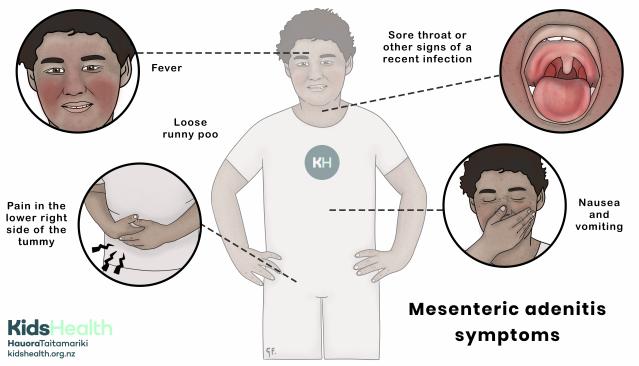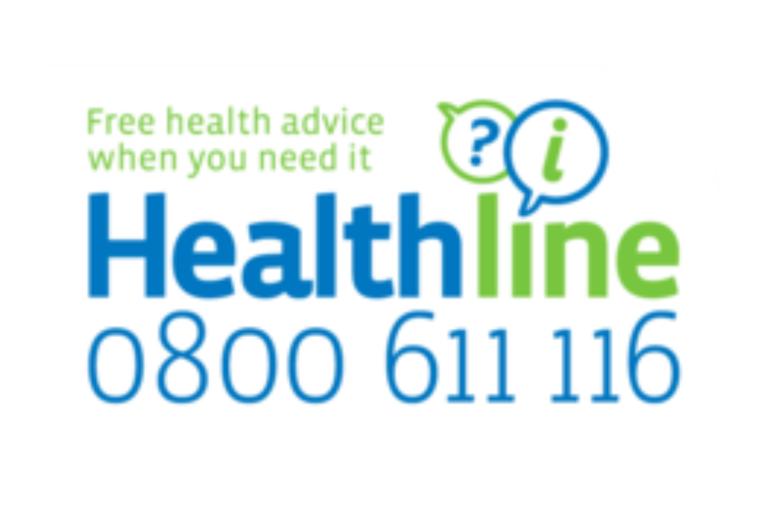Key points about mesenteric adenitis
- mesenteric adenitis is a common cause of tummy pain in tamariki
- it happens when the lymph nodes in the tummy become swollen, usually after a viral infection
- it often gets better on its own with rest and care at home
- the pain can be severe - if you are worried, see a health professional
What is mesenteric adenitis?
Mesenteric adenitis is when the small lymph nodes in the tummy become swollen and sore. These lymph nodes help the body fight off infections. Mesenteric adenitis is also sometimes called mesenteric lymphadenitis.
Mesenteric adenitis is common in tamariki and rangatahi (young people). It usually happens after a viral illness, like a cold or sore throat.
Symptoms of mesenteric adenitis
Symptoms of mesenteric adenitis in tamariki include:
- pain in the lower right side of the tummy
- a fever (high temperature)
- feeling sick in the tummy (nausea)
- vomiting
- loose runny poo (diarrhoea)
- a sore throat or other signs of a recent infection
Your child’s tummy pain might come and go, and it may feel worse when they move.

This illustration shows common symptoms of mesenteric adenitis. These include pain in the lower right side of the tummy, loose runny poo, fever, nausea and vomiting, and signs of a recent infection like a sore throat.
Source: KidsHealth
transcribeTranscript
The illustration shows a child standing with hands on hips. Several close-up circles highlight symptoms of mesenteric adenitis.
- The top left circle shows a flushed face, labelled 'Fever'.
- The top right circle shows the inside of a red, inflamed mouth and throat, labelled 'Sore throat or other signs of a recent infection'.
- The bottom left circle shows hands holding the lower right side of the stomach, labelled 'Pain in the lower right side of the tummy'.
- The bottom right circle shows a child covering their mouth as if about to vomit, labelled 'Nausea and vomiting'.
- The top left also has the label 'Loose runny poo'.
At the bottom right is the heading: 'Mesenteric adenitis symptoms'.
At the bottom left is the KidsHealth logo with the website: kidshealth.org.nz.
Causes of mesenteric adenitis
The most common cause of mesenteric adenitis is a viral infection, such as:
- a cold or sore throat
- a tummy bug (gastroenteritis)
Sometimes a bacterial infection can cause mesenteric adenitis, but this is less common.
Diagnosing mesenteric adenitis
If your child has tummy pain and you are worried, take them to a health professional.
The health professional will talk to you about your child’s symptoms and check their tummy.
There is no single test to confirm mesenteric adenitis. Your child may have other tests such as:
- a blood test
- a urine test
- a scan such as an ultrasound scan of the tummy
These tests can help rule out other conditions like appendicitis.
Could it be appendicitis?
Mesenteric adenitis can feel like appendicitis. Appendicitis is when the appendix becomes inflamed. Appendicitis also causes pain in the lower tummy.
Managing mesenteric adenitis
Most tamariki with mesenteric adenitis get better without medical treatment. Your health professional may recommend pain relief for your child if needed.
Looking after your child with mesenteric adenitis
Pain relief
Some tamariki may need pain relief for their tummy pain. You can give paracetamol if your child is in discomfort or miserable with a fever. You must follow the dosage instructions on the bottle or packet. It is dangerous to give more than the recommended dose.
Rest
Encourage your child to rest and take a break from sports and exercise. Let your child decide how active they want to be.
Food and fluid
Encourage your child to drink plenty of fluids. Offer them small amounts of water, often. Your child may not feel like eating much while they’re unwell. Their appetite will return as they start to get better.
When to get medical help for your child
Call Healthline on 0800 611 116 or see a health professional urgently if your child:
- has tummy pain that is getting worse
- has tummy pain that seems much worse on movement
- is drowsy and difficult to wake
- is vomiting and can’t keep fluids down
- has blood in their poo
- shows signs of dehydration
- is unwell and you're worried for any reason
Call 111 within New Zealand for urgent medical help (use the appropriate emergency number in other countries).
Healthline is available 24 hours a day, 7 days a week on 0800 611 116. Call Healthline if you need advice about a child of any age who is unwell, hurt, or has any symptoms of sickness. It's free to callers throughout New Zealand, including from a mobile phone.
Acknowledgements
Illustration by Dr Greta File. Property of KidsHealth.

